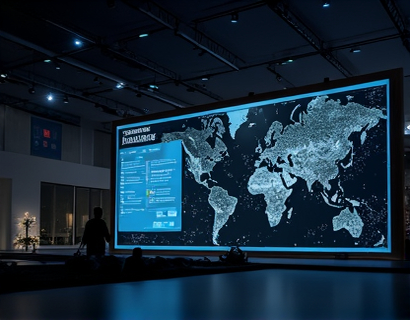Next-Gen QR Code Technology: Elevating Business Engagement and Social Media Interaction for Modern Brands
In the rapidly evolving digital landscape, businesses and social media managers are constantly seeking innovative ways to enhance engagement and deepen connections with their audience. One such technology that has emerged as a game-changer is the next-generation QR code, often referred to as enhanced or intelligent QR codes. These advanced QR codes go beyond the traditional static barcode, offering a range of customizable and intuitive tools that streamline information sharing and significantly boost customer interaction. This article delves into the transformative potential of next-gen QR codes, exploring how they are redefining business and social media engagement for modern brands.
The Evolution of QR Codes
QR codes, or Quick Response codes, were first developed in the 1990s primarily for tracking parts in vehicle manufacturing. Over the years, they have found widespread use in various sectors, from marketing and advertising to logistics and healthcare. Traditional QR codes are two-dimensional barcodes that can store text, URLs, and other data. However, their static nature and limited capabilities have been a constraint. The evolution to next-gen QR codes has addressed these limitations, introducing features that make them more versatile and user-friendly.
Key Features of Next-Gen QR Codes
Next-gen QR codes are designed with several advanced features that enhance their functionality and user experience. Some of the key features include:
- Dynamic Content: Unlike static QR codes, next-gen QR codes can be updated in real-time. This means that the information linked to a QR code can be changed without the need to create a new code. For businesses, this flexibility is invaluable as it allows for timely updates to promotions, product information, and more.
- Multi-Language Support: Next-gen QR codes can store text in multiple languages, making them ideal for global brands and businesses operating in multilingual markets. This feature ensures that the content is accessible to a broader audience, enhancing international engagement.
- Rich Media Integration: These QR codes can link to various media types such as videos, audio files, and interactive web pages. This rich media integration provides a more engaging and immersive experience for users, keeping them interested and involved.
- Customizable Designs: Next-gen QR codes offer extensive design customization options. Brands can create QR codes that match their visual identity, including logos, colors, and shapes. This personalization helps in building brand recognition and making the QR code more visually appealing.
- Analytics and Tracking: Advanced QR codes come with built-in analytics tools that provide insights into how the code is being used. Businesses can track the number of scans, user interactions, and other metrics to gauge the effectiveness of their campaigns and make data-driven decisions.
Enhancing Business Engagement
The integration of next-gen QR codes into business strategies can significantly enhance engagement with customers and stakeholders. Here are some ways businesses can leverage these codes to foster stronger connections:
Firstly, next-gen QR codes can be used to create interactive and dynamic marketing campaigns. For instance, a retail brand can place QR codes on product packaging that link to exclusive video content, behind-the-scenes footage, or special offers. This not only provides value to the customer but also encourages them to engage more deeply with the brand.
Secondly, in the context of events and trade shows, businesses can use QR codes to streamline the registration process and provide attendees with instant access to event schedules, speaker profiles, and other relevant information. This seamless experience enhances the overall event experience and leaves a lasting impression on attendees.
Additionally, next-gen QR codes can be employed in loyalty and rewards programs. By scanning a QR code, customers can earn points, access exclusive deals, or unlock special perks. The dynamic nature of these codes allows businesses to update rewards and promotions on the fly, keeping the program fresh and engaging.
Boosting Social Media Interaction
Social media platforms are a critical channel for brands to connect with their audience. Next-gen QR codes can play a pivotal role in enhancing social media interaction by bridging the gap between online and offline experiences. Here’s how:
One effective use case is in social media contests and giveaways. Brands can create QR codes that lead to contest pages or submission forms. By scanning the code, users can easily participate, increasing the likelihood of higher engagement and broader reach. The real-time update feature ensures that contest rules and details can be modified as needed.
Another innovative approach is to use QR codes to enhance user-generated content campaigns. For example, a fashion brand can place a QR code in a store that links to a social media challenge. Users can scan the code, participate in the challenge, and share their content using a specific hashtag. The brand can then feature the best submissions on their social media pages, creating a sense of community and encouraging more user participation.
Next-gen QR codes can also be used to provide instant access to social media profiles and live streams. By scanning a QR code, followers can be directed to a brand’s latest video content or live Q&A session, fostering real-time interaction and engagement. This immediacy helps in building a more connected and responsive audience.
Case Studies and Success Stories
Several brands have successfully implemented next-gen QR codes to elevate their engagement strategies. For instance, a leading automotive company used QR codes on their dealership windows to provide potential customers with instant access to vehicle specifications, pricing, and special offers. The dynamic content ensured that the information was always up-to-date, leading to higher conversion rates and improved customer satisfaction.
In the retail sector, a fashion retailer integrated QR codes into their in-store displays, linking to virtual try-on features and styling tips. This not only enhanced the shopping experience but also increased the average time spent in the store and the number of items per purchase. The customizable designs of the QR codes aligned perfectly with the brand’s aesthetic, reinforcing brand identity.
Another notable example is a travel agency that used QR codes on their marketing materials to provide travelers with instant access to itineraries, travel tips, and booking forms. The analytics tools provided valuable insights into user behavior, helping the agency refine their marketing strategies and improve customer engagement.
Challenges and Considerations
While next-gen QR codes offer numerous benefits, there are some challenges and considerations that businesses should keep in mind:
First, the success of QR code campaigns depends on user adoption and awareness. Brands need to educate their audience about the benefits of scanning QR codes and how to use them effectively. Clear signage and promotional materials can help in this regard.
Second, ensuring the security and privacy of user data is crucial. Businesses must implement robust security measures to protect user information, especially when using QR codes that link to sensitive content or require personal data input.
Third, the technical implementation of next-gen QR codes should be handled by professionals to avoid errors and ensure optimal performance. Incorrect setup can lead to frustrated users and negative brand perception.
Future Trends and Innovations
The future of QR code technology is promising, with ongoing innovations set to further enhance their capabilities. Some emerging trends include:
Integration with Augmented Reality (AR): Combining QR codes with AR can create immersive experiences where users can interact with digital content superimposed on the real world. For example, scanning a QR code could trigger an AR experience that showcases a product in action or provides an interactive tour of a location.
Blockchain Integration: Next-gen QR codes can be linked to blockchain technology to ensure transparency and security in transactions. This is particularly useful in industries like supply chain management, where tracking and verifying the authenticity of products is crucial.
Environmental Sustainability: There is a growing focus on creating eco-friendly QR codes using sustainable materials and production methods. Brands that prioritize sustainability can leverage this aspect to appeal to environmentally conscious consumers.
Conclusion
Next-gen QR codes represent a significant advancement in the realm of digital engagement for businesses and social media managers. Their customizable, dynamic, and interactive features offer a powerful tool to enhance customer interaction, streamline processes, and boost brand visibility. By embracing these innovative codes, brands can stay ahead in the competitive digital landscape, fostering deeper connections with their audience and driving meaningful engagement.










































